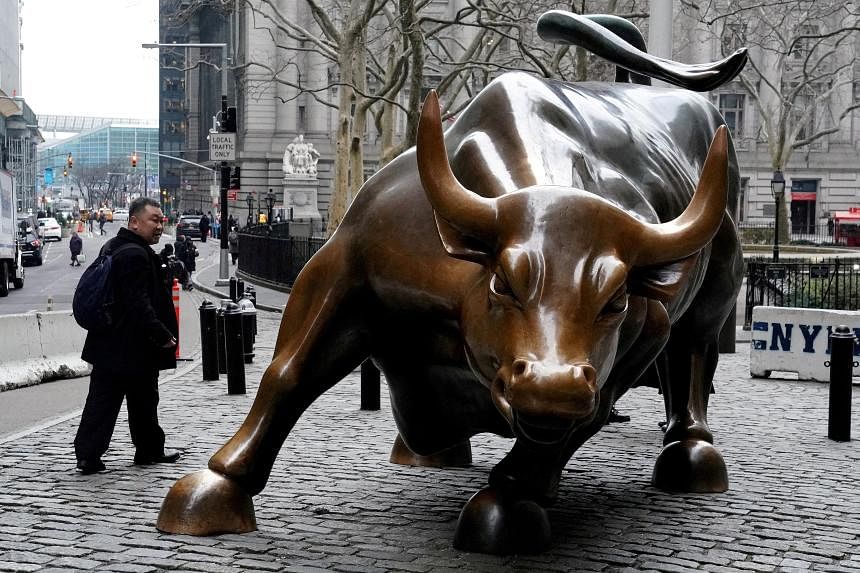SINGAPORE – Despite a weak close on March 22, equity markets have had a rip-roaring ride so far in 2024, fuelled by artificial intelligence (AI) hype and optimism about impending rate cuts.
On Wall Street, the Dow Jones Industrial Average had its best week since December as it gained 1.97 per cent for the week to 39,475.90 points. The broad-based S&P 500 index rose 2.29 per cent to 5,234.18 points, while the tech-heavy Nasdaq gained 2.85 per cent for the week to 16,428.82 points.
The biggest catalyst for the markets’ surge has been pronouncements made at the midweek US Federal Reserve Open Market Committee (FOMC) meeting, where chairman Jerome Powell sounded the most dovish since 2022.
The Federal Reserve left the Fed funds rate steady at a 23-year high of 5.25 per cent to 5.5 per cent for a fifth consecutive meeting. Addressing the media, Mr Powell said inflation was coming down, albeit in bumpy fashion. More importantly, he hinted at three rate cuts in 2024, possibly starting in June. All indications are that the Fed, guided by its dot plot, will cut its key rate by 75 basis points to the 4.5 per cent to 4.75 per cent range.
The news boosted risk-on sentiment.
Here in Singapore, the Straits Times Index responded to the FOMC outlook by gaining 1.4 per cent for the week to end at 3,217.97 points. But the gain was narrowly supported by the trio of banks, which averaged 2 per cent gains on the week, while the seven STI component Reits (real estate investment trusts) averaged 1.6 per cent gains during the week.
The broader Singapore market remains stuck in a moribund state, with almost half the total trading volume dominated by just one stock – Seatrium. It will be interesting to see what happens when Seatrium (formed by the merger of Sembcorp Marine and Keppel Offshore & Marine in 2023) completes its 20-into-one stock consolidation.
The huge undervaluation here is prompting a significant amount of buybacks, with the likes of City Developments, Yangzijiang Financial, ST Engineering, First Resources, Boustead and The Hour Glass purchasing their own stock.
Singapore Exchange data shows that institutions were net buyers of Singapore stocks over the five trading sessions last week, with over $260 million in net institutional inflow, including 23 primary-listed companies conducting buybacks worth more than $27 million.
So what’s next for the markets?
Despite all the optimism on Wall Street, one has to note that US inflation is at least 1 percentage point above the Fed’s declared target of 2 per cent. Bringing inflation down from 9 per cent to about 3.2 per cent has been the easy part. Dragging it further down to 2 per cent could prove challenging, given the tight labour market and global supply-chain issues.
That said, the scenario today is vastly different from 40 years ago, when then Fed chair Paul Volcker brutally wrestled down double-digit inflation in the 1970s and early 1980s. The result was a painful recession and mass joblessness.
Today, despite two years of Fed tightening, the job market remains resilient and unemployment is near record lows. Consumer spending is still robust. Corporate earnings remain resilient. The US and global economy remain generally buoyant. There have been no massive supply-chain shocks despite disruptions, localised conflicts and trade wars.
And the markets have rallied to record highs.
Also, as analysts often like to point out, there is some US$6 trillion (S$8.1 trillion) in cash on the sidelines which could find its way back into the markets as falling rates start depressing risk-free returns.
By all accounts, the markets’ upside appears intact.
Looking into the second quarter, Mr Mark Haefele, chief investment officer at UBS Global Wealth Management, sees two primary market drivers playing out: the start of rate-cutting cycles by major central banks, and the broadening out of AI adoption and implementation across a wider range of companies.
He recommends holding a diversified strategic exposure to the technology sector, including some of the likely winners from tech disruption. “We foresee 18 per cent earnings growth for the global technology sector this year and 72 per cent annualised growth in AI revenues over the next five years,” he says.
But he also warns against the risk of over-concentrating portfolios, and advises a structured strategy of diversification beyond technology into quality stocks across regions; in alternative growth themes like the energy transition, healthcare disruption, and water scarcity; and in small- and mid-cap stocks.
Investors should be proactive and shift their cash and money market holdings towards more durable sources of income, including fixed-term deposits, short-term bond ladders, and medium-duration high-quality bonds, he adds.
“The temptation to manage risk by simply cashing in on gains or retreating to the sidelines may be strong, but history favours those who pursue a more balanced approach. We believe that only by diversifying across asset classes, regions and sectors can investors effectively manage the tension between navigating short-term market dynamics and growing long-term wealth.”
While the likes of Nvidia and other tech stocks have dominated the investment conversation, investors should also seek opportunities in AI-enabled industries beyond technology, such as healthcare, finance and manufacturing, says Mr Nigel Green, chief executive of independent financial consultancy deVere Group.
“While Silicon Valley is synonymous with AI innovation, AI hubs are emerging worldwide, from Tel Aviv to Beijing,” Mr Green notes.
“Investing in companies operating in these burgeoning AI ecosystems allows investors to tap into global talent pools and diverse markets, diversifying risk and capturing upside potential.”
In the Singapore context, there are companies across the listed spectrum showing resilient earnings, strong growth prospects and paying generous dividends. Many are deeply undervalued. Investors should do some homework, crunch the numbers and consult market experts.
Also, don’t react to short-term volatility, advises Mr Vasu Menon, managing director for investment strategy at OCBC Bank.
“Whether one is bullish or bearish on markets cannot be answered without a time overlay,” he says. “Investors may get spooked if they look at short-term data, but they should not lose sight of the fact that investments require taking a medium-term view and from this time horizon, the outlook remains constructive.”
This week will see quite a bit of “Fedspeak”, with the likes of Fed governors Raphael Bostic, Austan Goolsbee, Lisa Cook and Chris Walker making pronouncements. Mr Powell will also speak. There will be a slew of data on joblessness claims, consumer spending, home sales, durable goods and personal consumption expenditure hitting the markets.
While some do worry about a potential market bubble, the overwhelming recommendation by strategists is to stay invested for the medium term and ignore the short-term noise.
Given what we know, the markets are likely to end the year higher than where they are now. It’s all about picking the right plays.


